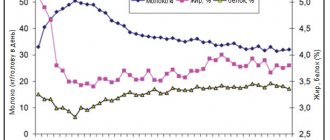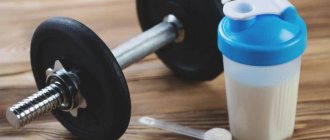Why should you eat after a workout?
Every day, your body is constantly breaking down and synthesizing muscle protein(s).
This process is known as “protein turnover,” and when viewed as a whole, the rate of breakdown (breakdown) and the rate of synthesis tend to balance each other. In other words, the amount of protein that the body synthesizes during the day, at the same time, manages to compensate for the process of protein breakdown. Thus, opposing processes neutralize each other throughout the day.
However, when you train, everything changes.
Research shows that the rate of protein synthesis decreases during strength training and cardio, and that the rate of protein breakdown increases dramatically shortly after you finish pumping.
In other words, exercise is a catabolic activity, and this especially applies to exercise on an empty stomach and long periods of exercise.
(This is why the bodybuilding adage that you don't build muscles in the gym is true. The stress of strength training breaks down muscle tissue, causing micro tears in the fibers and breakdown of the protein they contain, and healing, repair and growth occurs during "damage repair" ” - rest between workouts.)
Strictly speaking, then, muscle growth is the result of a rate of protein synthesis (increasing its intensity) exceeding the rate of breakdown over a long period of time.
Therefore, if you want to gain muscle as quickly as possible, then your task is to do everything possible to keep the rate of protein synthesis at or above the rate of protein breakdown.
The more time your body spends in an anabolic state, the faster you will gain muscle.
This is one of the reasons why you should eat enough calories and protein every day, why various strategies to speed up muscle recovery can help, and why nutrition after strength training is a staple in the bodybuilding world.
The purpose of a post-workout meal is simple:
Restrain muscle breakdown and increase muscle tissue synthesis levels.
And it works.
Anyway, that's the point. How does it actually manifest itself, though?
What is the carbohydrate window?
The carbohydrate window is a conditional period after the end of strength training, during which the athlete’s muscles are most sensitive to the absorption of nutrients (primarily proteins and fast carbohydrates). It is believed that the energy from the carbohydrate cocktail consumed at this time is spent primarily on muscle recovery and growth, and not at all on gaining fat mass.
The carbohydrate window is considered to last from 30-45 minutes after low-intensity strength training to 2-4 hours after an active circuit or HIIT workout¹. In addition, consuming fast carbohydrates immediately before starting physical training is also beneficial for muscle growth and is included in the concept of the metabolic window².
To close the carbohydrate window after strength training, you need about 15-25 g of sports protein and 10-12 g of fast carbohydrates. This will help lower cortisol levels, stop the process of muscle breakdown and start the process of muscle growth. At the same time, the maximum amount of fast carbohydrates after training, which guarantees an increase in body weight without excessive fat growth, is 30-40 g.
// How much protein and carbohydrates do you need after training:
- 10-12 g fast carbohydrates
- 15-25 g whey protein
Gainer: a source of fast carbohydrates
A gainer is a carbohydrate-protein cocktail, which is a mixture of whey protein, fast carbohydrates, creatine and vitamins. Consuming such a cocktail to close the carbohydrate window causes an increase in body weight - but both muscle and fat reserves grow. That is why taking a gainer is recommended only for ectomorphs who are prone to thinness and have problems with muscle growth.
When training for muscle definition (that is, for cutting) or during any training for fat burning, a gainer is categorically not recommended. In most cases, to stop catabolic processes, a serving of whey protein and a sufficiently small amount of simple carbohydrates (about 10 g) in the form of maltodextrin, a small fruit or 100 ml of juice are enough.
Why eat protein after a workout? And is it necessary?
Yes, eating protein after a workout is a good idea.
And here's why and for what...
It initiates muscle building by stimulating the rate of protein synthesis in the muscles.
Let us remember that as soon as we finish pumping muscles, the level of breakdown of muscle tissue goes up, easily exceeding the rate of its synthesis.
Gaining muscle mass cannot happen until the tide turns (the rate of synthesis exceeds the rate of breakdown), and consuming protein after training does just that.
The main driving forces here are the amino acid leucine, which directly stimulates protein synthesis and is especially abundant in some types of protein, such as whey protein and beef, and the hormone insulin, which suppresses the rate of muscle tissue breakdown and provides nutrition for cells.
So, in short, you eat protein and your body digests and breaks it down into its constituent amino acids, including leucine.
These amino acids are then absorbed into the bloodstream along with insulin, which slows the rate of muscle fiber breakdown and stimulates muscle protein synthesis to give advantage to synthesis over breakdown.
Protein eaten after the stress of strength training has been removed stimulates protein synthesis more than when consumed at rest (when you rest between exercises).
Eating protein stimulates muscle protein synthesis no matter when you eat it, but eating it immediately after pumping enhances this effect.
https://youtu.be/yXhkD5S_Y1E
Anaerobic training and nutrition
Anaerobic means without oxygen, that is, when performing such types of exercise you spend less oxygen than during aerobic exercise. This can be explained using the example of two runners: a sprinter and a marathon runner. If you look at them, you will understand everything without me - one of them builds muscle and trains strength, and the other loses mass and trains endurance.
Now about the amount of oxygen. When running 100 meters in 10 seconds, the sprinter practically does not breathe, or his breathing is frequent and intermittent. The marathon runner is aimed at a different result - he must run as far as possible. If he holds his breath or breathes quickly, he will not run even 500 meters. He must adjust his breathing so that the supply of oxygen is constant and dosed. By oxidizing fatty acids with oxygen, a marathon runner provides himself with energy.
How does a weightlifter’s body work during training? The main source of energy during anaerobic exercise, that is, short-term exercise with heavy weight, is glycogen, that is, glucose. Yes, but glycogen is a substance found in muscle tissue, which means that during training we use our own muscles. To prevent this from happening, athletes who work to increase muscle mass need to receive additional carbohydrates and proteins in large quantities. Protein is the main building material for muscles. Without it, muscle growth is almost impossible. In general, anaerobic exercise burns fewer calories than aerobic exercise. However, the process of burning calories is delayed for another 48 hours after training - the body works to restore damaged muscle fibers.
The ratio of proteins/fat/carbohydrates in the diet of a weightlifter should be 30%/10%/50%.
Why eat carbohydrates after a workout? And is it necessary?
Maybe.
We are often told to eat carbohydrates post-workout to spike insulin levels, which is supposed to enhance muscle growth through various anabolic mechanisms.
Unfortunately, research indicates that this doesn't work. Adding carbohydrates to your post-workout diet does not appear to accelerate muscle growth.
The reason for this is that only a moderate increase in insulin is necessary and sufficient to ensure the highest possible rate of muscle protein synthesis, provided it is combined with a sufficient dose of protein, which in itself is sufficient to achieve the desired insulin concentration.
I will note, however, that adding carbohydrates to your post-workout meal will keep insulin levels elevated longer, which is desirable from a muscle-building standpoint because, as you know, insulin prevents the breakdown of muscle tissue (by inhibiting the rate at which catabolic processes occur in the body).
This is one of the reasons why high-carb diets are better for building muscle than low-carb diets.
High carbohydrate diets generally produce higher levels of insulin, which in turn generally produces lower levels of muscle tissue breakdown.
Another benefit of carb-loading after exercise is that it replenishes your muscles with glycogen, which is burned as energy when you exercise, and especially during high-intensity exercise.
This buildup of glycogen throughout your body may give you a nice post-workout pump and boost your mood, but it doesn't seem to improve your overall exercise performance if you train again later in the day.
In other words, you don't have to rush to replenish your glycogen stores if you might need them again later in the day.
It is also worth noting that the body will not store carbohydrates as fat until glycogen stores are full, so it is often recommended to eat the most carbohydrate-rich meals immediately after training.
It's debatable whether this can benefit body composition over time, but it certainly can't hurt.
Main types of training
Let's say that you come to the gym with an already existing knowledge about proper nutrition in general. This means that you are aware of the benefits of protein, the quality of carbohydrates and fats that should be present in the diet of any athlete. However, there are some subtleties associated with the functioning of the body during various types of training. That is, our body works differently if you perform exercises from the arsenal of a bodybuilder or a sprinter.
There are a great many types and subtypes of sports and training programs, but they are all divided into 2 main ones. These are aerobic and anaerobic workouts. I'll tell you about each in more detail.
Aerobic training involves high repetitions with light weights or your own body weight. With these types of exercise, it is very important to increase the heart rate and the amount of oxygen consumed. Due to this, fatty acids are oxidized in the body. That is, such training is aimed primarily at burning fat and developing endurance, training the cardiovascular system. Despite the fact that the main source of energy during aerobic exercise is fat reserves, carbohydrates are no less important. After the start of training, glucose, which is formed in the body from incoming carbohydrates, is a source of energy. Lack of glucose leads to fatigue, muscle cramps, fainting, and generally reduces the quality of training and athletic performance.
Anaerobic training is considered to be training that is aimed at muscle growth - few repetitions with heavy weights. These types of training include all types of weightlifting: bodybuilding, powerlifting, etc. Also some types of training that combine strength and aerobic exercise, for example, CrossFit. Nutrition under such loads requires a large amount of protein in the diet and carbohydrates. The amount of fat in the diet is significantly reduced.
Which workout is best?
It doesn't matter what sport you play, what matters is how you eat and whether you have the right balance of nutrients in your diet for your type of exercise.
Why eat fat after a workout? And is it necessary?
Of course, if you want.
Some bodybuilders argue that you shouldn't because it slows down the process of digestion and absorption of proteins and carbohydrates that the body needs after a workout.
Well... while it's true that adding fat to a protein- and/or carbohydrate-rich meal slows down the rate at which your stomach clears food, it's not true that it makes post-workout nutrition less effective.
For example, research has repeatedly shown that the fat content of a meal does not affect the rate of glycogen replenishment and that whole milk may be more anabolic than skim milk.
So, there is no need to eat fat after weight training, but there is nothing wrong with it, either.
What are the rules of life?
Research is good, but there is also the practice of practicing athletes. It is more accurate, because from experience it is easier to calculate how much protein you should drink after training and during the day. Slightly larger portions are recommended here. In particular, the optimal dosage is considered to be 2.6-3.3 grams during “drying”, when the task is to achieve ideal relief, and 2.2 grams in normal mode. By the way, almost the same data were obtained as a result of another study from the University of Auckland. Here, scientists have identified the optimal dosage - 2.3 - 3.1 grams per kilogram of mass.
How soon should you eat after training?
No discussion of post-workout nutrition is complete without mentioning the “anabolic window.”
The idea here is that once you've finished training, you should eat within a certain amount of time to maximize muscle gain (30 to 60 minutes is the general consensus).
If not, they say, you won't be able to build muscle as quickly as you could.
How true is this, though?
Well, it depends on when you last ate before class.
If you haven't eaten for 3-4+ hours before exercise, it is likely that your insulin and muscle protein synthesis levels will be at a low baseline, in which case it would make sense to eat only protein immediately after exercise.
If you don't do this, you won't miss out on a unique opportunity to build muscle faster, but your body won't be able to start building muscle until the mechanism is in motion, and that won't happen until you eat.
However, if you have eaten within a couple of hours before starting strength training, and especially if the meal contained a significant amount of protein, then the timing of post-workout nutrition is less important.
Your body will still be processing the food you ate, so you can eat right after your workout if you want, but you can also wait an hour or two.
What is protein and why is it important for the body?
Protein is a nutrient that is made up of molecules called amino acids. This is the basic building material for the body. Our tissues, such as muscles, ligaments, tendons, hair, internal organs and skin, are made of protein. This also applies to hormones, enzymes and other vital substances. The body needs 21 amino acids to form protein. The body can synthesize 12 of them, but 9 must be obtained from food. Therefore, the amino acids that are included in this “nine” are called essential. These include:
- phenylalanine;
- valine;
- threonine;
- tryptophan;
- methionine;
- leucine;
- isoleucine;
- lysine;
- histidine
The main reason we need to eat protein is to provide our body with the essential amino acids it needs to repair and build tissue.
Of course, exercise increases the body's need for protein, but people who lead a sedentary lifestyle also need this nutrient. If they don't eat enough protein, they start to lose muscle faster. Research shows that the faster muscle loss occurs, the higher the risk of premature death.1
From a physiological point of view, protein not only increases the level of amino acids in the blood. It also stimulates protein synthesis in the body (the biological process in which amino acids form new proteins). Specifically, the body forms muscle protein, which is used to repair and grow muscles.
The opposite process is protein breakdown, where the body breaks it down into amino acids. These processes, to varying degrees of severity, always occur in the body.
Muscle mass gain occurs when protein synthesis prevails over its breakdown. This condition is also called “positive protein balance.” Conversely, the predominance of breakdown (catabolism) leads to muscle loss - the so-called negative protein balance.
Under normal conditions, these two conditions have the same severity, so muscle volumes are approximately at the same level.2
People who don't exercise don't lose or gain muscle over time (in fact, their muscle mass slowly decreases, but it's virtually unnoticeable in the short term).
So, everything we do to gain muscle faster—work out in the gym, eat plenty of protein and calories, take the right supplements, etc.—has one or both of the following effects:
– increases the rate of muscle protein synthesis;
– reduces muscle protein breakdown.
Strength training, for example, significantly increases levels of protein synthesis, so it helps increase muscle mass.
When it comes to maximizing muscle growth, the basic principles of proper diet, training, and proper recovery are the main methods to achieve your goal. You need:
– eat enough protein every day;
– eat enough calories every day;
– perform mainly basic, multi-joint exercises;
– provide progressive muscle overload (gradually increase the load);
– get a good night’s sleep;
– do not train at maximum intensity for several months in a row.
Doing all of the above will provide about 80% of your result. This means that all other strategies and advice will always be less important. But "less important" does not mean "useless."
Therefore, it is recommended not only to adhere to the basic rules, but also to do something else, in particular, take sports nutrition (especially creatine and beta-alanine), pay attention to the timing of protein intake, and also keep cardio to a minimum. Individually, these things won't make much difference, but together they can make a big difference in the long run. So, let's move on to the question of when to consume protein.
What about post-workout sports nutrition? What supplements speed up muscle recovery and growth?
There are entire shelves and racks of “post-workout supplements” that marketers falsely tell us are a must-have for accelerating muscle recovery and growth.
Most of this is nonsense, but there are a few options worth considering:
- Whey protein because it is rich in leucine and provides a dramatic increase in plasma amino acid levels, making it a particularly good source of post-workout protein.
- Creatine because it helps you increase muscle mass and strength faster, and research indicates that taking it after doing weight training is best.
- Fish oil because it has an impressive list of health benefits, and research shows that it can speed up muscle protein synthesis when combined with food.
What type of protein is best for pre- and post-workout consumption?
Great, now you know when to eat protein before a workout and whether to eat after it.
What types of protein should you eat before or after workouts? Does it really matter?
Ideally, you should have something that quickly increases plasma amino acid levels and therefore the rate of protein synthesis, and that is rich in the amino acid leucine to directly stimulate muscle growth. You need something from the category of fast proteins after training.
The protein source that best fits the above, and is also the most popular protein supplement in the world, is whey protein.
Whey is quickly absorbed and rich in leucine, so it significantly increases the rate of protein synthesis and can therefore be eaten before and after exercise.
While any type of protein supplement has a stimulating function, we're all for whey protein isolate because it's so close in composition to pure protein and doesn't contain lactose, which can potentially upset your stomach.
Post-workout nutrition summary
A lot has already been said about the fact that nutrition before and after training are the most important important meals of the day.
This is simply not true.
As long as your overall diet is set up correctly, no single meal is ranked higher than another.
In other words, as long as you eat enough calories every day and your macros are set properly, when you eat, it won't disrupt or cause a break or your gains.
This suggests that it's wise to eat protein every few hours if you want to maximize muscle growth, and this will typically entail eating foods within an hour or two before and after exercise.
So I usually recommend eating 30 to 40 grams of protein an hour or two before and after your workout.
I also recommend including carbohydrates in these meals and meals, because it makes the pump more effective and keeps insulin levels generally higher after the load is removed.
Last but not least, your post-workout meal may contain fat, but you won't benefit from it, so do what you prefer in terms of fat inclusion.
How to reduce body weight
1. Food should be varied. Very often, those who go on a diet quickly break down and attack unhealthy foods with even greater greed than before. And all because, strictly following a diet, they adhere to strict rules and eat the same foods. Purely psychologically, it is difficult to withstand more than 1-2 weeks. In addition, the same products will not be able to provide your body with all the beneficial substances it needs. Therefore, avoid a monotonous diet.
2. Monitor your caloric intake. It is very important to create a calorie deficit to start losing weight. Without this it is impossible to lose weight - this is a fact. Of course, you can resort to the help of a plastic surgeon, but you will not change the way your body works.
3. Completely eliminate or reduce simple carbohydrates from your diet. They are the ones who make us gain weight and trigger the accumulation of fat reserves. The level of insulin in the blood provokes a brutal appetite.
What sweets can you afford?
4. Eat slowly . Very often, people who eat quickly do not immediately notice that they are full. The stomach does not have time to send a signal to the brain that it is full. Thus, the person overeats. Eat slowly, chew your food thoroughly, your stomach will thank you. By the way, hot food is very harmful to the stomach, so let it cool a little.
5. Eat regularly, don't skip meals. Eat small meals every 2-3 hours. This will control your appetite and prevent overeating.
6. Cut yourself some slack. A strict diet always leads to a breakdown. To prevent this from happening, allow yourself to eat your favorite treat or dish once a week. The calorie jump will help the body get rid of addiction. This means that your metabolic rate will remain high.
7. Drink more water. The water balance in the body is difficult to overestimate. We are 80% water. Drinking water 30 minutes before meals will help you eat less and not feel hungry between breaks.
Use of glucose in medicine. Against poisoning and stress
This is a universal antitoxic agent that helps with infectious diseases. Glucose maintains the volume of circulating plasma, helps replenish the balance of fluids and easily accessible elements necessary for the functioning of the body. It easily penetrates into all cells of the body, which is why it is valued in medicine. A glucose solution increases pressure in cells and activates basic metabolic processes. Stimulates the functioning of the liver, kidneys, heart, activates the production of many hormones and enzymes . Once in the blood, it gives a feeling of calm and stability. In addition, the immunomodulatory effect of glucose was discovered.
This remedy is prescribed in the following cases:
- hypoglycemia;
- liver diseases;
- infectious diseases;
- dehydration (diarrhea, vomiting);
- insufficient carbohydrate content in food;
- shock and collapse;
- heart disease (stimulates myocardial function);
- stress.
Glucose in tablet form is given to the sick, injured and convalescent. Helps maintain the health of people who work in extreme conditions: miners, oil workers, military personnel. In addition, it is used in antibiotics and other medicines. Excellent for diluting certain medications when injecting them into a vein. Glucose is contraindicated in diabetes mellitus and high blood sugar levels (hyperglycemia).
Glucose in bodybuilding / Glucose and training
I hope this article helps many people clear up the confusion surrounding whey protein. In many ways, this is a good protein, but you need to be realistic - you will not build mountains of muscle in a short time just by including this product in your diet.
Author: Will Brink
It never ceases to amaze me how popular whey protein is as a form of sports nutrition, but at the same time it causes a lot of confusion and inconsistency of information. What's the matter? I can say that this is due, first of all, to the unfair advertising of some sports nutrition manufacturers, as well as the appearance of low-quality publications or “studies” with “authoritative” opinions of various kinds of specialists in the field of nutrition. And finally, we must agree that whey protein is indeed a “complex” product. In this article, I take the risk of finding out everything once and for all, lifting, so to speak, the veil of secrecy and dispelling the myths that shroud this most popular type of sports nutrition. After reading my article, you will understand the difference between the different forms of whey protein: what is the difference between concentrate and isolate, or protein that is produced by microfiltration versus protein that is produced using ion exchange technology. You will also find out the answers to many other difficult questions that have caused you doubts and uncertainty.
What is whey protein?
When we talk about whey protein, we mean a complex product or mixture that consists of several protein subfractions: beta-lactoglobulin, alpha-lactalbumin, immunoglobulins (IgGs), glycomacropeptides, bovine serum albumin (BSA) and lower peptides (enzymes): lactoperoxidase , lysozyme (muramidase) and lactoferrin. Each of the subfractions isolated from whey has unique biological properties. Until recently, it was possible to obtain such subfractions only in quantities necessary for laboratory research. It was very expensive and unprofitable to produce it on an industrial scale. But in the last decade, completely new filtration technologies have appeared that make it possible to isolate subfractions with very high biological activity from whey (for example, lactoferrin and lactoperoxidase). Too little of these subfractions are present in cow's milk (usually less than 1%). For example, of the total whey protein contained in cow's milk, lactoferrin makes up about 0.5% or less. This is one of the promising subfractions that can be used to prevent many diseases and help improve overall health. Breast milk contains up to 15% lactoferrin. In the last ten years, there has been a qualitative and quantitative increase in whey protein powder (the appearance of concentrates and isolates).
What's good about whey protein?
Whey protein is truly a wonderful product, otherwise it would not be a staple of the diet for most bodybuilders and other athletes. In recent times, this product is also becoming popular among people who are trying to live a healthy lifestyle and are aware of its immune-boosting properties. As recent studies show, whey protein helps fight cancer, HIV, reduces stress and cortisol levels, increases immunity and serotonin levels in the brain, improves liver function in patients who suffer from certain forms of hepatitis, lowers blood pressure, improves overall well-being, not to mention the increase in athletic performance among athletes representing different sports. Whey protein has exceptionally high biological nutritional value (although sports nutrition manufacturers SIGNIFICANTLY exceed the significance of this fact). In addition, it contains many branched chain amino acids (BCAAs). One of the main properties of whey protein is its ability to increase the level of glutathione (GSH), an important tripeptide that regulates the human immune system, which is also an antioxidant. The concentration of glutathione inside the cell is directly related to the ability of lymphocytes (an important component of the immune system) to respond to a threat to human health. Thus, changing the content of intracellular glutathione can be considered one of the methods of immune modulation. Glutathione is a tripeptide consisting of L-cysteine, L-glutamine and glycine. Cysteine contains the free sulfhydryl group of GSH and is the limiting factor in glutathione synthesis (although the effect of serum on glutathione is more complex than just its cysteine moiety). Whey protein has a place in everyone's diet, as glutathione is considered an important factor in supporting immunity (oxidative stress, general health, and reduced glutathione levels associated with a long list of diseases). Decreased glutathione levels are also associated with overtraining syndrome in athletes, making whey protein ideal for preventing, or at least mitigating, overtraining. When it comes purely to sports, some recent research suggests that whey protein may have a direct impact on overall performance and muscle growth in athletes, but this research is considered preliminary at best. The research also found that since oxidative stress contributes to muscle fatigue, high levels of glutathione in the blood will enable you to train longer and harder.
Different Types of Whey Protein
The confusion surrounding whey protein comes when it comes to its forms: concentrates, isolates, ionic purified protein, etc. Next I will try to explain the difference to you.
Concentrate
The pure protein content in the first generation whey protein powder did not exceed 30-40%. In addition, the powder contained lactose, fats and undenatured proteins. This protein was considered a “concentrate” and was used in the food industry for baking and some other products. Modern concentrates contain up to 70-80% protein, a limited amount of lactose and fat. Many people believe that dry concentrate is inferior in quality to isolate, but they are wrong. Despite the fact that the concentrate does contain less protein per gram of mixture, when compared with isolate, they contain a lot of useful substances that are absent in protein isolates. For example, good concentrates contain an incomparably larger number of growth factors IGF-1, TGF-2 and TGF-2. In addition, they contain much more phospholipids and bioactive lipids, such as linoleic acid (CLA), as well as immunoglobulins and lactoferrin. We do not have reliable data to judge the effect that these compounds have on muscle growth and physical fitness in athletes, but we can assume, again based on these results, that they may help improve immunity, improve gastrointestinal health and have a number of other positive effects not only among athletes, but also among “ordinary” people. The disadvantages of concentrated whey protein powders may be lower protein content per gram of product weight compared to isolates, a higher amount of fat (although this is a controversial issue, since there may be healthy fats here too), as well as a higher lactose content. There is no need to assume that high-quality whey concentrate is worse than any isolate. It's possible that concentrate might even be a better choice depending on your goals. For example, some people are lactose intolerant and count every gram of fat in their diet, while others have no such problem and may want to take advantage of the additional benefits of concentrates due to their more complex composition.
Isolates
Whey protein isolates typically contain up to 90-96% protein. Research shows that whey proteins can only retain biological activity when they are in their natural, undenatured state (i.e., their natural conformational state). The manufacturer needs to try hard to ensure that when lactose, fats and other components are removed from the protein, its high bioavailability is preserved. Preservation of the natural undenatured form of proteins is very important for their anticancer and immunomodulatory activity. To maintain its natural state, the protein must be processed at low temperatures and/or in a low acidity environment. This is a very important stage in the entire technology for obtaining isolate, which is not present in the production of concentrates. Isolates contain at least 90% protein with minimal inclusion of lactose and almost complete absence of fat. In this regard, and in terms of protein content per gram of weight, isolate is superior to concentrated protein. However, we already know that whey protein is a complex mixture of many components, and it would not be entirely correct to judge the superiority of a particular product based only on the quantitative protein content. Using ion exchange technology, for example, isolates with the highest protein content are obtained. Does this mean that this protein is the best of all isolates? Not at all, but many companies still consider this to be their “goal” when trying to create superior whey protein.
Ion exchange
Whey isolate, which is obtained by ion exchange, is produced by passing the protein concentrate through a special column. This looks strange and not entirely clear, doesn't it? But ion exchange has a significant drawback. It was said above that whey protein is a complex protein product, which includes many peptide subfractions with their own unique properties. Some subfractions are present in serum in very limited quantities. In fact, the subfractions ultimately make whey protein the unique product that it naturally is. During ion exchange, many of these fine and vital subfractions are destroyed or depleted, even though the protein content of the final product increases. This is the main disadvantage of the ion exchange method, which cannot be considered the optimal way to obtain high-quality third-generation whey protein. However, many manufacturers use this technology to obtain maximum protein concentration in their products. In protein obtained by ion exchange, 70% or more of beta-lactoglobulin is retained (ironically, the most uninteresting subfraction, which at the same time has high allergenic properties), but this leads to the fact that many other biologically active components are lost. Thus, we can recommend this type of whey protein for those people for whom a high percentage of protein is important, but at the same time they are willing to sacrifice the absence of a number of important biologically active components destroyed during the processing. In my opinion, this cannot be called an optimal solution, given the minimal difference between the products obtained using ion exchange and the microfiltration method, which will be discussed below.
Isolates obtained by microfiltration
So, it's time to learn about microfiltration whey isolates. Progress does not stand still, and nowadays manufacturers have learned to produce unique whey protein isolates using cross-filtration microfiltration (CFM®), ultra-filtration (UF), microfiltration (MF), reverse osmosis (RO), dynamic membrane filtration (DMF) technologies, ion exchange chromatography (IEC), electrical ultrafiltration (EU), radial flow chromatography (RFC) and nanofiltration (NF). Perhaps the most common method that most of us have heard of is microfiltration (CFM®). \"Cross microfiltration" is usually called several options for protein processing, which uses fine purification of the concentrate in a low-temperature environment. The result is a product with a protein content of at least 90%, preserved useful subfractions, a very low level of fat and lactose and an almost complete absence of undenatured proteins. Cross-Filtration Microfiltration (CFM®) is a natural, non-chemical process that uses high-tech ceramic filters, as opposed to ion exchange, which uses chemical catalysts such as hydrochloric acid and caustic soda. Cross-filtered microfiltration (CFM®) whey isolate is also high in calcium and low in sodium.
The Future of Whey Protein
There are several promising directions for creating the next generation of whey proteins.
Increasing the percentage of useful protein subfractions
The development of technologies that are associated with the isolation of individual bioactive subfractions from whey (for example, lactoferrin or glycomacropeptides) on an industrial scale, using already existing methods of processing raw materials, looks very promising. This could only have been a dream a few years ago, but now some whey protein manufacturers are already using the latest filtration technologies. Therefore, it would be possible to create products with specifically tailored properties: isolating subfractions and then returning them to refined products to restore their natural chemical-biological properties (for example, lactoferrin, which is simply removed from whey with existing purification methods). The highest quality products today contain only 0.5-1.0% of this rare but very important microfraction. A number of manufacturers today could artificially increase its content, creating truly “designer” proteins with unique properties. It has been reported that one company is actively exploring the possibility of creating isolates with increased levels of alpha-lactalbumin, another beneficial subfraction of whey, and virtually no beta-lactalbumin, which often causes an allergic reaction. Such isolates potentially surpass in quality and beneficial properties all other whey proteins available on the market. Don't forget about concentrates. Manufacturers could increase their content of growth factors (IGF-1, TGF-1 and TGF-2) and other bioactive components in the form of phospholipids, conjugated linoleic acid (CLA), immunoglobulins and lactoferrin. These products will also contain more fat (from 5-10% to approximately 15%), but only due to the increased content of disease subfractions.
Return of hydrolyzed proteins
Many of us remember the boom associated with hydrolyzed proteins. Until recently, they were very popular; after their appearance, they created a lot of noise and then quickly disappeared from store shelves. By “hydrolysis” we mean the partial breakdown of proteins into peptide chains of different lengths. Since protein enters the body in a split form, it should be absorbed much faster, which may be important in some circumstances (for example, for people with severe burns, patients with diseases of the digestive system, or when feeding premature babies). How beneficial hydrolyzed forms of protein are for athletes is a topic for another conversation. The hype around hydrolyzed protein stemmed from the publication of laboratory results where mice fed the hydrolyzed form of the protein had increased nitrogen retention (positive nitrogen balance) in contrast to another group of rodents fed regular protein. It’s a shame, but no one dared to conduct similar experiments on athletes. Be that as it may, this type of protein did not last long on the market. Consumers did not like its disgusting taste, cost and lack of reliably confirmed facts of its “miraculous” effect. If during hydrolysis the protein practically turns into denatured alcohol. One of the companies has developed its own splitting technology. The result is a completely natural product with normal taste. The cost of producing hydrolyzed protein has also decreased. The only thing missing is extensive human studies of similar products. However, many bodybuilders and other athletes may be interested in this protein.
Minerals from milk?
Milk can be a source of beneficial minerals for bodybuilders and other athletes. Milk contains a biologically active form of calcium that can be extracted without the lactose found in fermented milk products. In addition, milk contains magnesium, phosphorus and zinc, which are necessary for normal osteogenesis and metabolism. Recent studies show that supplemental calcium intake, for example, helps lower blood pressure. Bodybuilders and other athletes will be interested in the fact that more and more studies are confirming the relationship between increased calcium levels in the body and a metabolic shift towards active lipolysis (fat breakdown) and suppression of lipogenesis (fat formation). In other words, by adding calcium and other minerals obtained from dairy raw materials to sports nutrition, we get an optimal product that helps speed up metabolism, gain lean muscle mass and strengthen bone tissue.
Conclusion
OK it's all over Now. I hope that my article helped you finally understand the questions that you had when you mentioned whey proteins. You are now a savvy consumer who understands the issue, and when you make your next purchase at a sports nutrition store, you will now know what you need. Don't be fooled! This is a very good protein in many ways, but you have to be realistic - you won't build mountains of muscle in a short time just by including this product in your diet. I also advise you to keep your finger on the pulse and constantly be interested in new developments in the field of sports nutrition products.
Carbohydrates replenish glycogen stores
The main reason to consume carbohydrates post-workout is to replenish the muscle glycogen you burned during your workout. When you exercise, your main source of fuel is muscle glycogen . Glycogen is a storage form of glucose that consists of long chains of branched glucose molecules.
Glucose is released from the glycogen chain as needed to produce ATP , which carries energy and is key for muscle contraction . Research confirms that the best way to replenish muscle glycogen stores after exercise is high-glycemic carbohydrates [13]
Some "experts" claim that regular gym workouts don't burn enough glycogen to warrant replenishment . However, it is not. When you deplete any amount of muscle glycogen, you should take care to restore , especially if muscle growth is your main goal. If a trainer claims that people don't need to worry about glycogen replenishment , then their training is weak and at very low intensity, or they haven't looked at any research. [12]
A study on glycogen utilization during strength training found that workouts that included 6-20 sets of approximately 15-30 minutes depleted muscle glycogen stores by approximately 30-40 percent . If your workouts last 60-90 minutes , you need to move quickly between exercises, or you prefer high-intensity workouts like cardio or Tabata, then such workouts will deplete your muscle glycogen by as much as 60-75 percent . [2] So take your post-workout carbohydrate intake seriously and be sure to your muscle glycogen stores If you don't do this, you are cheating your muscles and limiting their recovery. Based on the study, delaying carbohydrate consumption by just 2 hours showed a reduction in the rate of glycogen replenishment by as much as 50 percent! [2]
Some experts also argue that most people in the gym don't do this because there is evidence that, whether you consume carbohydrates immediately after exercise or two hours later, glycogen levels replenish themselves within 24 hours . However, there is no significant evidence of this information. Therefore, the fastest way to replenish glycogen stores is to consume carbohydrates with a high glycemic index immediately after exercise.
Full restoration of glycogen levels as soon as possible after exercise is essential for muscle growth. Glycogen stored in muscle cells attracts water into them, thereby increasing the volume of the muscle cell and thus the fullness of the muscle fibers. [9]
Considering that you pump up your muscles during exercise, which also increases the amount of water in the muscle cells and therefore their volume, then quickly replenishing muscle glycogen can help you maintain high muscle cell volume over a long period. This may be important because evidence suggests that high muscle cell volume triggers changes in muscle that also lead to long-term muscle growth. [3]
The next benefit of eating carbohydrates, and especially high-glycemic carbohydrates such as dextrose, immediately after an intense workout is that you will feel energized . Carbohydrates help get rid of lethargy after a hard workout and give you energy . Also, eating high-glycemic carbohydrates post-workout tends to satisfy cravings for sweet or starchy carbohydrates without negatively impacting your diet. [9]
During training
The next element of nutrition analysis during intense training is what to take immediately before and during training.
Amino acids
In this case, the choice of many bodybuilders is amino acids. Moreover, these are not necessarily BCAA amino acids, but any high-quality amino acid complex of essential acids. Plus, during training you can take a separate portion of glutamine if it is not contained in the amino acid complex.
Amino acids will provide the body with energy during training, especially if you are in the stage of giving your body relief and are limited in calorie intake, in this case amino acids will preserve muscles from decay.
Also, during particularly intense training, it is recommended to take isotonic drinks to restore the lost part of the microelements, namely the electrolytes necessary for the body to function normally. During training, these microelements are excreted through sweat and their deficiency must be replenished.
Fructose is not fast enough
Fructose, which makes up 50% of the sugar in most fruits, honey and sucrose, is actually a low glycemic index carbohydrate . Fructose is a type of sugar that the body doesn't use very well. Due to its structure, it cannot be directly converted into muscle glycogen like glucose.[4]
So when you consume fructose in the form of fruit or high fructose corn syrup, it is not immediately absorbed into the bloodstream like dextrose. Instead, most of it is forced to move to the liver , where it can be converted into glucose and stored as glycogen. This occurs when the liver deems it necessary to blood glucose levels [4]
Because glucose does not optimize muscle glycogen recovery, it is not the best post-workout option. This is one of the main reasons why you should choose gummies and candies instead of fruits or other sweets. Most candies use high fructose corn syrup or sugar as the main sweetener. ( sucrose) is approximately 50% fructose and 50% glucose , while high fructose corn syrup is approximately 55% or more fructose . In contrast, most gummy bears contain dextrose and corn syrup. Corn syrup is primarily glucose and is significantly different from the contaminant-laden high fructose corn syrup.











